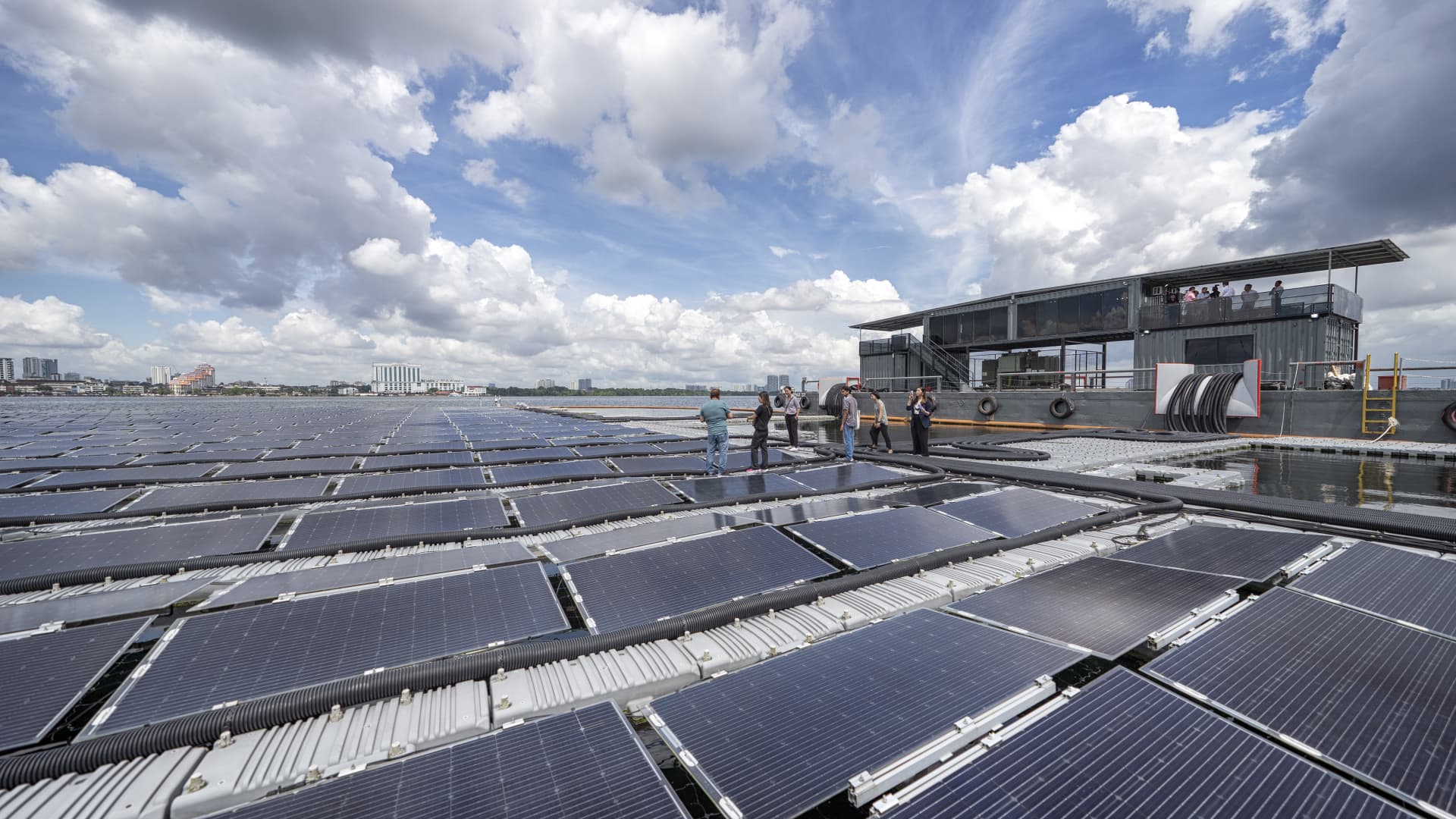Southeast Asia looks to renewable power for energy security
Southeast Asia looks to renewable power for energy security CNBC


Energy Transition in Southeast Asia

Sustainable Development Goals (SDGs)
- Goal 7: Affordable and Clean Energy
- Goal 9: Industry, Innovation, and Infrastructure
- Goal 13: Climate Action
Southeast Asia is home to some of the world’s fastest-growing economies. As energy demand grows, the region is turning to renewable energy to safeguard its energy security.
Energy demand in Southeast Asia has increased by an average of 3% each year over the past two decades — a trend that will continue to 2030 under current policy settings, according to the International Energy Agency.
But fossil fuels still dominate the region’s energy mix, making up about 83% in 2020 compared to renewables’ share of 14.2% in the same period, research from the ASEAN Center for Energy showed.
By 2050, oil, natural gas and coal will account for 88% of the total primary energy supply, the center said.
This “huge dependence” on fossil fuels increases the region’s vulnerability to energy price shocks and supply constraints, said Zulfikar Yurnaidi, manager of energy modeling and policy planning at the ASEAN Center for Energy.
Global events such as the pandemic and Russia’s invasion of Ukraine have driven up prices in recent years, with benchmark oil prices reaching its highest level in over a decade in March last year. Just last week, oil prices popped nearly 6% as Middle East tensions soared following Hamas militants’ air, sea and land assault on Israel.
“Our fiscal capacity is different from Europe. We can’t outbid everyone to get our own gas supply,” said Yurnaidi.
In particular, Southeast Asia’s gas and coal power sectors have expanded as power grows, increasingly exposing these markets to volatile fossil fuel prices on the international market, said David Thoo, power and low carbon energy analyst at BMI Fitch Solutions.
“Overall, the region’s policies and trends show countries are eager to transition to clean energy.”
– Zulfikar Yurnaidi, ASEAN Center for Energy
If Southeast Asian nations do not make significant discoveries or add to existing production infrastructure, the region will become a net importer of natural gas by 2025 and coal by 2039, the ASEAN Center for Energy estimated. That’s going to raise fossil fuel prices and exert further strain on consumers.
To prevent this, the region must diversify its energy sources for economic growth and security, said Yurnaidi.
Most, if not all, Southeast Asian markets have taken strides to announce renewable energy targets and formulate their low-carbon energy transition plans, said Thoo.
“Overall, the region’s policies and trends show countries are eager to transition to clean energy,” said Yurnaidi.
Energy Transitions from Malaysia to Indonesia
- Malaysia
Malaysia launched its National Energy Transition Roadmap in July, which will scale up its renewable energy capacity and reduce its growing dependence on natural gas imports, according to the Ministry of Economy.
The roadmap identified 10 flagship projects, including plans to build a one-gigawatt solar photovoltaic plant — Southeast Asia’s largest — that can directly convert sunlight into energy, the ministry said.
Solar power has remained the most encouraging segment of Malaysia’s renewable energy landscape since 2011, with an installed capacity compound annual growth rate of 48%, according to the authorities.
Other planned developments include an integrated renewable energy zone, five centralized large-scale solar parks and three green hydrogen production plants. These projects will leverage Malaysia’s estimated 290 gigawatts of technical renewable energy potential to create a more resilient, low-carbon power system, said the ministry.
- Vietnam
In May, Vietnam announced its Power Development Plan 8, a commitment to boost wind and gas energy while reducing its reliance on coal.
Renewable energy sources such as wind and solar are projected to account for at least 31% of national energy needs by 2030, the government said, according to Reuters.
Under the plan, all coal plants must be converted to alternative fuels or cease operations by 2050, said the release. Although coal will remain an important energy source in the near term, accounting for an estimated 20% of the country’s total energy mix in 2030, it would be a decrease from nearly 31% in 2020, said Reuters.
- Singapore
Singapore’s Green Plan 2023 similarly emphasizes an uptake in renewable energy. It targets an increase in solar energy deployment to at least 2 gigawatts of capacity by 2030, which will meet about 3% of projected electricity demand, said the Ministry of Sustainability and the Environment.
About 95% of Singapore’s electricity is generated from natural gas, a fossil fuel energy source, according to the ministry.
Although Singapore’s geographical constraints limit its renewable energy options, the plan will implement measures like rooftop solar panels as well as importing electricity and hydrogen from other Southeast Asian countries to reduce reliance on fossil fuels.
Last year, Singapore’s Keppel Electric signed a two-year agreement with Laos to import up to 100MW of renewable hydropower through Thailand and Malaysia. This marked Singapore’s first renewable energy import, as well as the first multilateral cross-border electricity trade involving four ASEAN members, reported local media.
“It is clear that the region understands the role of energy reliability and resilience amidst various energy shocks,” said Yurnaidi.
- The Philippines
Southeast Asian markets are also looking to attract foreign companies with expertise on renewable energy to develop their renewables sectors, said BMI’s Thoo.
“Renewables [here] are fairly less developed than China and Western markets,” he added.
In November, the Philippines removed Filipino ownership requirements
SDGs, Targets, and Indicators
1. Which SDGs are addressed or connected to the issues highlighted in the article?
- SDG 7: Affordable and Clean Energy
- SDG 9: Industry, Innovation, and Infrastructure
- SDG 13: Climate Action
The article discusses the need for Southeast Asia to transition to renewable energy sources to ensure energy security and address the region’s dependence on fossil fuels. This aligns with SDG 7, which aims to ensure access to affordable, reliable, sustainable, and modern energy for all. The article also mentions the development of renewable energy projects and the importance of attracting foreign investment, which relates to SDG 9, promoting sustainable industrialization and fostering innovation. Additionally, the transition to clean energy contributes to SDG 13, which focuses on taking urgent action to combat climate change and its impacts.
2. What specific targets under those SDGs can be identified based on the article’s content?
- SDG 7.2: Increase the share of renewable energy in the global energy mix
- SDG 9.4: Upgrade infrastructure and retrofit industries to make them sustainable
- SDG 13.2: Integrate climate change measures into national policies, strategies, and planning
The article highlights the need to increase the share of renewable energy in Southeast Asia’s energy mix to reduce dependence on fossil fuels. This aligns with SDG 7.2, which aims to increase the share of renewable energy in the global energy mix. The development of renewable energy projects and the emphasis on attracting foreign investment also contribute to SDG 9.4, which focuses on upgrading infrastructure and retrofitting industries to make them sustainable. Furthermore, integrating climate change measures into national policies and strategies, as mentioned in the article, supports SDG 13.2.
3. Are there any indicators mentioned or implied in the article that can be used to measure progress towards the identified targets?
- Percentage of renewable energy in the total energy mix
- Investment in renewable energy projects
- Number of renewable energy projects implemented
- Reduction in greenhouse gas emissions
The article mentions the need to increase the share of renewable energy in Southeast Asia’s energy mix, which can be measured by tracking the percentage of renewable energy in the total energy mix. The emphasis on attracting foreign investment and the development of renewable energy projects indicate potential indicators such as investment in renewable energy projects and the number of projects implemented. Additionally, the transition to clean energy is expected to contribute to a reduction in greenhouse gas emissions, which can serve as an indicator of progress towards the targets.
Table: SDGs, Targets, and Indicators
| SDGs | Targets | Indicators |
|---|---|---|
| SDG 7: Affordable and Clean Energy | Increase the share of renewable energy in the global energy mix (7.2) | – Percentage of renewable energy in the total energy mix – Investment in renewable energy projects – Number of renewable energy projects implemented |
| SDG 9: Industry, Innovation, and Infrastructure | Upgrade infrastructure and retrofit industries to make them sustainable (9.4) | – Investment in renewable energy projects – Number of renewable energy projects implemented |
| SDG 13: Climate Action | Integrate climate change measures into national policies, strategies, and planning (13.2) | – Reduction in greenhouse gas emissions |
Behold! This splendid article springs forth from the wellspring of knowledge, shaped by a wondrous proprietary AI technology that delved into a vast ocean of data, illuminating the path towards the Sustainable Development Goals. Remember that all rights are reserved by SDG Investors LLC, empowering us to champion progress together.
Source: cnbc.com

Join us, as fellow seekers of change, on a transformative journey at https://sdgtalks.ai/welcome, where you can become a member and actively contribute to shaping a brighter future.







